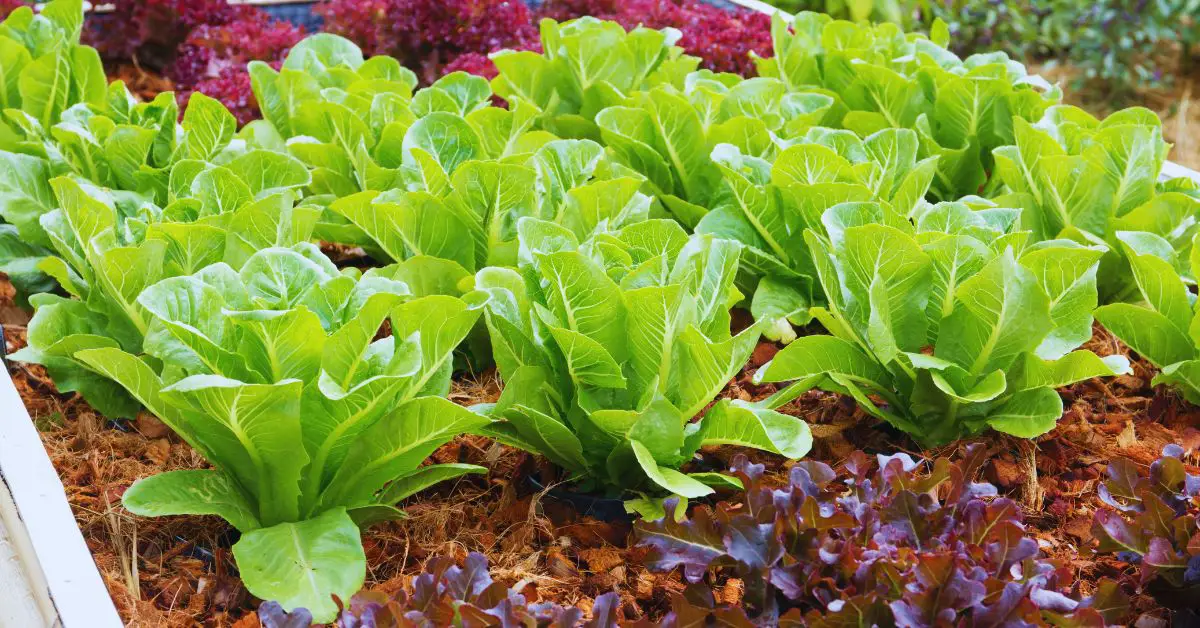As you consider alternative gardening methods, you may have stumbled upon straw bale gardening, a technique that’s gained popularity for its eco-friendly and productive approach.
But what exactly is straw bale gardening, and how can you harness its potential to grow a thriving garden? By utilizing decomposing straw bales as a nutrient-rich medium, you can create an ideal environment for your plants to flourish.
But that’s just the beginning – to access the full benefits of this innovative method, you’ll need to know how to choose the right bales, prepare them for planting, and select the best crops to grow.
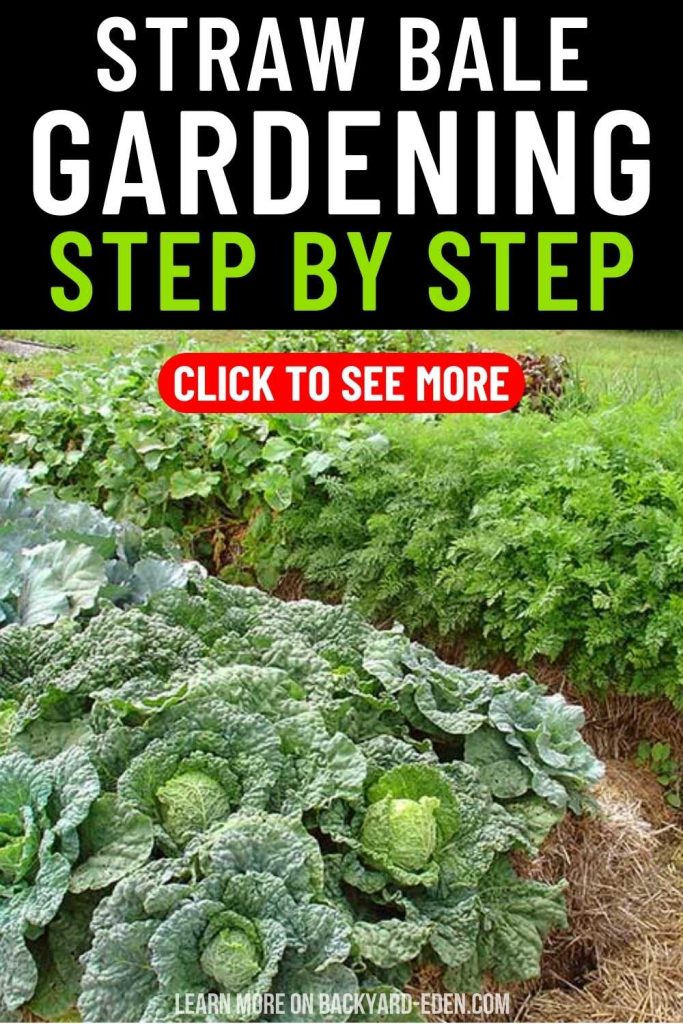
Key Takeaways
- Straw bale gardening is a sustainable, eco-friendly method that uses nutrient-rich bales as a growing medium for plants.
- Conditioning straw bales before planting involves soaking and sterilizing them to create an ideal environment for plant growth.
- Selecting crops adaptable to straw bale conditions, such as vegetables and herbs, and implementing crop rotation strategies ensures a thriving garden.
- Proper watering and moisture management techniques, like direct watering and monitoring moisture levels, are crucial for healthy plant growth.
- By using natural pest control methods and organic fertilizers, straw bale gardeners can promote healthy plant growth and minimize environmental impact.
What Is Straw Bale Gardening?
By exploring straw bale gardening as a growing medium, you’re effectively creating a nutrient-rich, self-contained ecosystem that fosters healthy plant growth. This innovative method has been around for centuries, with evidence of its use dating back to ancient China and Europe.
The history of straw bale gardening is rooted in its benefits, which extend beyond the garden itself. By using straw bales, you’re reducing waste and minimizing environmental impact. Traditionally, straw is discarded after harvesting, but straw bale gardening gives it a new purpose. This sustainable approach reduces the need for fertilizers and pesticides, promoting a healthier environment.
As you investigate this unique gardening method, you’ll find that it not only benefits your plants but also contributes to a more eco-friendly lifestyle. By embracing straw bale gardening, you’re joining a community that values environmentally conscious practices.
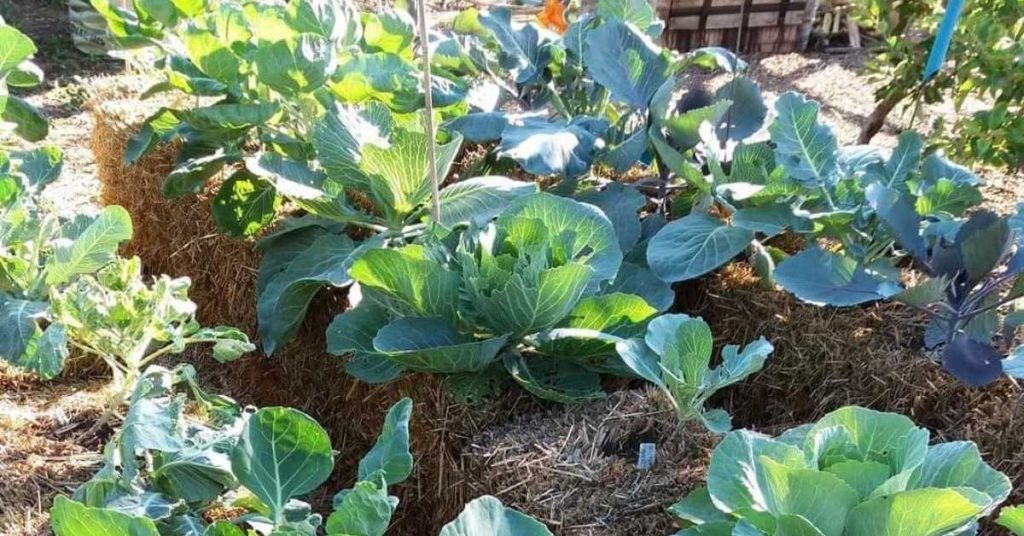
What Are The Benefits of Straw Bale Gardening?
As you adopt straw bale gardening, you’ll start to reap numerous benefits that extend beyond the scope of your garden, impacting your entire approach to sustainable living.
One of the most significant advantages is the environmental benefits it provides. By using straw bales, you’re reducing waste and promoting a closed-loop system where organic matter is cycled back into the ecosystem. This approach also encourages a reduction in synthetic fertilizers and pesticides, creating a healthier environment for you and your community.
Straw bale gardening also offers exceptional soil conditioning benefits. As the straw breaks down, it adds organic matter to the soil, improving its structure, fertility, and water-holding capacity. This, in turn, supports a thriving ecosystem, teeming with beneficial microorganisms and insects.
With straw bale gardening, you’ll notice improved soil aeration, increased water retention, and a more resilient soil ecosystem. These benefits won’t only enhance your garden’s productivity but also contribute to a more sustainable and environmentally conscious lifestyle.
Choosing the Right Straw Bales
You’ll need to select straw bales that are specifically suited for gardening to reap the benefits of this sustainable method, and that starts with understanding the characteristics of high-quality bales.
When sourcing bales, prioritize straw quality, as it directly impacts the growing conditions within your garden. Look for bales with a high straw-to-weed ratio, as weeds can compete with your plants for water and nutrients. Opt for bales with a dry, compact, and dense structure, which will retain heat and moisture better. Avoid bales with signs of mold, mildew, or pest infestations, as these can spread disease and pests to your plants.
When it comes to bale sourcing, consider local farmers, garden centers, or online suppliers. Make sure the bales are specifically labeled as ‘gardening quality’ or ‘straw bale gardening’ to guarantee they meet the necessary standards. Be cautious of bales intended for animal bedding or construction, as they may contain contaminants or chemicals harmful to your plants.
Preparing Straw Bales for Planting
Two weeks prior to planting, begin conditioning your straw bales by soaking them thoroughly with water. This triggers an internal decomposition process that will eventually turn the straw into a nutrient-rich growing medium. This process, known as bale conditioning, breaks down the organic matter, making it suitable for plant growth. During this period, the bales will heat up, and you may notice a sweet, earthy aroma – a sign that the decomposition process is underway.
To guarantee a healthy growing environment, it’s vital to sterilize the bales to eliminate any weed seeds or potential pests. You can do this by applying a 10% bleach solution to the bales, making sure to wear protective gear when handling the solution. This step is important in preventing unwanted competition for your desired crops.
Once the bales have undergone conditioning and sterilization, they’re ready for planting. By following these steps, you’ll create an ideal environment for your plants to thrive in, and you’ll be one step closer to enjoying a bountiful harvest from your straw bale garden.
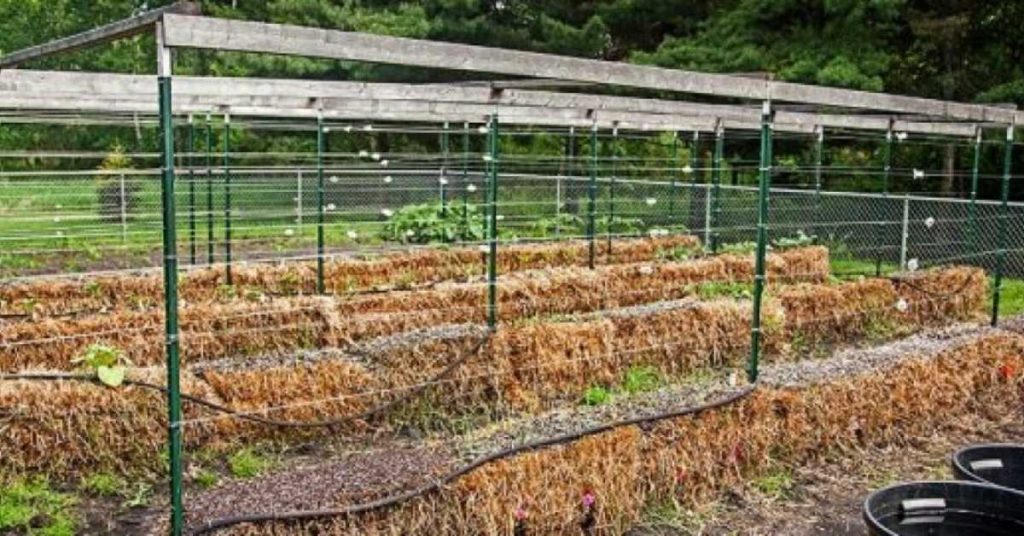
Selecting the Best Crops to Grow
When selecting crops for your straw bale garden, you’ll want to choose varieties that thrive in this unique environment.
You’ll need to take into account factors like moisture and nutrient requirements, as well as the mature size of each plant.
Crop Selection Criteria
To maximize yields and minimize frustrations, consider selecting crops that thrive in the unique conditions provided by straw bale gardens. Soil temperature, moisture, and nutrient availability differ from traditional soil-based gardens.
You’ll want to choose crops that are adaptable to the warm and dry conditions that can occur on the surface of the bale, as well as those that can tolerate the cooler and moister conditions found deeper in the bale.
When selecting crops, consider implementing crop rotation strategies to optimize yields and reduce pest and disease pressure. For example, rotating heavy-feeding crops like tomatoes with light-feeding crops like lettuce can help maintain soil health.
Additionally, consider the seasonal growing patterns of your crops. Cool-season crops like broccoli and kale thrive in the cooler temperatures of spring and fall, while warm-season crops like tomatoes and peppers excel in the heat of summer.
Ideal Vegetable Choices
You’ll find that vegetables like cucumbers, squash, and carrots thrive in straw bale gardens, thanks to their ability to adapt to the unique conditions and moisture levels found within the bales. These vegetables have characteristics that make them ideal for straw bale gardening, such as shallow root systems and low water requirements.
When selecting vegetables for your straw bale garden, consider those that benefit from the warm and moist environment within the bales. For example, vining vegetables like peas and beans can take advantage of the bale’s vertical space, while plants like lettuce and spinach appreciate the consistent moisture levels.
By choosing the right vegetables, you can create a thriving and diverse garden that showcases the benefits of straw bale gardening. Consider incorporating garden styles like companion planting, where vegetables are paired to enhance growth and deter pests.
Planting in Straw Bales Successfully
By properly preparing your straw bale garden, you’ll increase the chances of successful planting and a bountiful harvest. To start, make sure you’re using high-quality straw, free of mold and weeds. Opt for bales with a tight, compact structure, as they’ll retain heat and moisture better.
When arranging your bales, consider a grid pattern to allow for easy access and air circulation. Place the bales with the cut side up, and secure them with twine or wire to prevent them from toppling over.
When planting, create a hole in the bale by removing a small amount of straw. Add a handful of compost or fertilizer, and then plant your chosen vegetable or herb. Water gently but thoroughly, and keep the bale consistently moist during the first few weeks.
As the straw breaks down, it’ll provide nutrients to your plants, promoting healthy growth. With proper care and attention, your straw bale garden will thrive, providing you with a bountiful harvest and a sense of community with fellow gardeners.
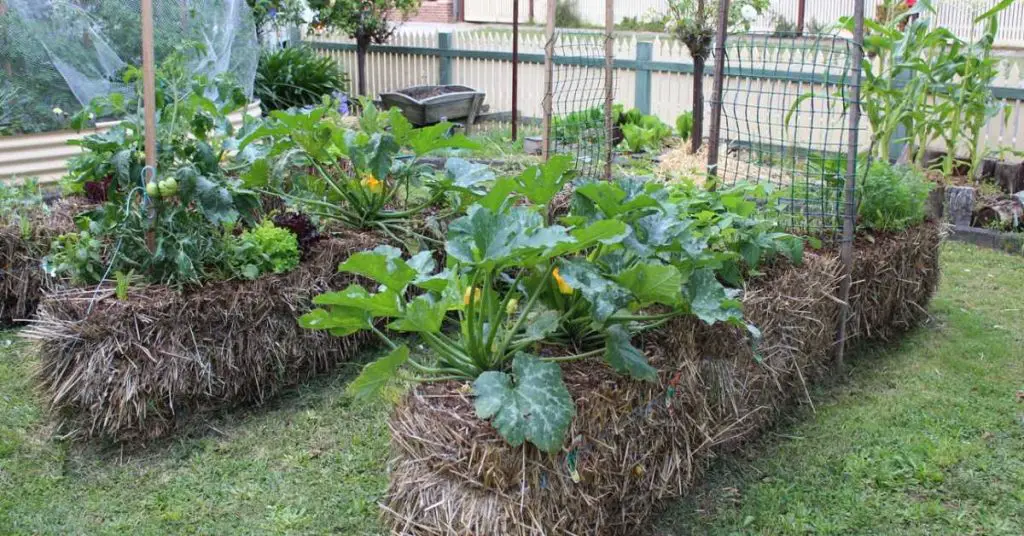
Watering and Maintaining Bales
As you start watering and maintaining your straw bale garden, it’s crucial to grasp the significance of soaking the bales properly, monitoring bale moisture levels, and meeting daily water requirements.
You’ll need to guarantee your bales receive sufficient moisture, especially during the initial conditioning phase. By doing so, you’ll create a favorable environment for your plants to thrive.
Soaking the Bales
Soaking the bales regularly is essential to create an ideal environment for microorganisms to thrive, which in turn supports healthy plant growth.
As you water your straw bale garden, you’ll notice the bales absorbing water like a sponge. This process is known as bale absorption, where the straw fibers soak up water and retain it for later use. This water retention is vital, as it allows the bales to release water as needed, providing a consistent supply to your plants.
To soak your bales effectively, water them thoroughly once or twice a week, depending on weather conditions. You can also use a soaker hose or drip irrigation system to deliver water directly to the roots of your plants, reducing evaporation and runoff.
Bale Moisture Levels
You’ll need to monitor and adjust the moisture levels of your bales regularly to guarantee ideal growing conditions. This is essential, as straw bales that are too dry can impede plant growth, while overwatering can lead to rot and decay.
To maintain ideal moisture levels, perform a daily bale inspection. Check the bales by inserting your hand into the straw or using a moisture sensor to determine the moisture level. If the bale feels dry to the touch or the moisture sensor indicates low moisture, it’s time to water. Conversely, if the bale is waterlogged, reduce watering frequency.
Aim for a moisture level between 60% and 70%. This ideal range allows for healthy microbial activity, which breaks down the straw and releases nutrients for your plants. By maintaining optimal moisture levels, you’ll create a thriving environment for your plants to grow.
Regular bale inspection and moisture monitoring will help you achieve the perfect balance, ensuring a successful straw bale garden.
Daily Water Requirements
How much water does your straw bale garden need daily to thrive? The answer depends on several factors, including the bale’s moisture level, temperature, and humidity. As a general rule, your straw bale garden requires about 1-2 inches of water per week, either from rain or irrigation. However, this can vary depending on the climate and soil conditions.
To ensure optimal watering, it’s essential to implement an irrigation scheduling system. This involves monitoring the bale’s moisture levels and adjusting your watering schedule accordingly. For instance, if the bale is too dry, you may need to water more frequently. Conversely, if the bale is too wet, you may need to reduce watering to prevent waterlogged conditions.
As you water your straw bale garden, remember to prioritize water conservation. Aim to use a drip irrigation system or soaker hose to minimize evaporation and runoff. By adopting these practices, you’ll not only conserve water but also promote healthy plant growth and reduce your environmental footprint.
Controlling Weeds and Pests Naturally
When starting to plant and maintain your straw bale garden, it’s essential to develop a strategy for controlling weeds and pests naturally, without relying on chemical pesticides or herbicides that can harm the environment and human health.
One effective method is to create natural barriers to prevent weeds from growing in the first place. You can do this by laying down a layer of landscape fabric or cardboard around your straw bales, which will block weeds from germinating.
Additionally, you can use physical barriers like copper tape or crushed eggshells to deter slugs and snails.
Companion planting is another natural method to control pests. By planting certain herbs and flowers alongside your vegetables, you can repel pests and attract beneficial insects. For example, basil repels aphids and marigolds attract ladybugs, which prey on aphids.
Dealing With Common Problems
As you tend to your straw bale garden, you’ll likely encounter some common issues that can impact its health and productivity.
You’ll need to be proactive in preventing pest infestations, which can quickly destroy your crop, and also keep a close eye on moisture levels to avoid waterlogged or dried-out bales.
Pest Infestation Prevention
By taking proactive measures, you can effectively prevent pest infestations from ruining your straw bale garden. One of the most important ways to do this is through companion planting. By strategically planting certain vegetables, herbs, and flowers alongside your crops, you can deter pests naturally.
For example, planting marigolds with tomatoes can help repel nematodes, while basil and mint can help keep pests away from vegetables. Another vital step in preventing pest infestations is crop monitoring. Regularly inspect your plants for signs of pest damage, such as holes, discoloration, or actual pests. This will enable you to catch any issues early on and take swift action.
Keep a garden journal to track your observations and identify patterns. By combining companion planting and crop monitoring, you’ll be well-equipped to prevent pest infestations and maintain a thriving straw bale garden.
Moisture Balance Issues
You’ll encounter moisture balance issues if you don’t maintain the ideal moisture level in your straw bale garden, which can lead to stunted growth, rot, and poor yields. When the bales are too dry, plants will struggle to thrive, and when they’re too wet, you’ll face dampness concerns and waterlogging risks.
This important balance is essential, as excess moisture can cause the straw to break down prematurely, reducing its lifespan.
To avoid these issues, check the moisture level of your bales regularly. Stick your finger into the bale up to your knuckle; if the straw feels dry, it’s time to water. If it’s already moist, wait another day before checking again.
Be cautious not to overwater, as this can lead to waterlogging risks, causing roots to rot and plants to suffer. By maintaining the ideal moisture balance, you’ll create a healthy environment for your plants to flourish.
With attention to moisture levels, you can enjoy a bountiful harvest from your straw bale garden.
How to Fertilize Straw Bale Garden
Understanding the fertilization needs of your straw bale garden is crucial as you navigate this unique gardening method. To promote healthy plant growth, you’ll want to focus on adding organic matter that’s rich in nutrients.
One effective way to fertilize your straw bale garden is by using compost tea. This liquid solution is made by steeping compost in water, creating a nutrient-rich liquid that benefits your plants.
Another option is to incorporate worm casting, the nutrient-dense waste produced by worms, into your fertilization routine. Worm casting is an excellent natural fertilizer that’s high in nitrogen, phosphorus, and potassium, making it an ideal addition to your straw bale garden.
When applying compost tea or worm casting, make sure to dilute the solution according to the recommended ratio to avoid burning your plants’ roots.
Extending the Life of Straw Bales
Continuing to reap the benefits of your thriving straw bale garden, it’s important to implement strategies that extend the life of your bales, ensuring they remain a nutrient-rich haven for your plants.
To achieve this, focus on bale preservation, an essential aspect of straw bale gardening. One effective longevity strategy is to maintain ideal moisture levels, as excessive water can lead to premature decomposition. You can achieve this by watering your bales gently but thoroughly, avoiding overwatering.
Another key strategy is to monitor and control temperature fluctuations, as extreme temperatures can impact bale decomposition. By keeping your bales in a shaded area or using a breathable cover, you can regulate temperature extremes.
Additionally, consider adding a layer of mulch or organic matter around your bales to retain moisture and suppress weeds. By implementing these bale preservation techniques, you’ll be able to extend the life of your straw bales, ensuring a healthy and thriving garden.
Harvesting and Enjoying Your Crop
As your straw bale garden reaches maturity, it’s time to reap the rewards of your labor by harvesting and enjoying the fruits of your labor, carefully selecting the ripest and healthiest produce to guarantee peak flavor and nutrition. You’ve worked hard to nurture your straw bale garden, and now it’s time to savor the benefits of your efforts.
Harvest your crops regularly to encourage continuous production and prevent over-maturation.
As you gather your fresh produce, consider incorporating it into fresh recipes that highlight the flavors and textures of your homegrown delights. You might create a summer salad featuring juicy tomatoes, crisp lettuce, and fragrant basil, or whip up a hearty soup starring your homegrown carrots and potatoes.
Your straw bale garden’s bounty is the perfect excuse to host seasonal celebrations, inviting friends and family to share in the joy of your harvest. Whether you’re hosting a summer solstice soiree or an autumn harvest feast, your straw bale garden’s fresh flavors will be the star of the show.
Tips for Straw Bale Gardening Success
To guarantee a flourishing straw bale garden, you’ll want to monitor and adjust the moisture levels, temperature, and pH balance of your bales regularly, as these factors greatly impact the health and productivity of your crops. By doing so, you’ll create a perfect environment for your plants to flourish.
One key gardening hack is to make sure your bales are consistently moist, but not waterlogged, as this will promote healthy soil microbes and robust plant growth. To extend the growing season, consider using row covers or cold frames to protect your crops from extreme temperatures. Additionally, incorporating season extension techniques will allow you to enjoy a longer harvest period.
When designing your straw bale garden, don’t forget to take into account garden aesthetics – strategically placing your bales can create a visually appealing space. By implementing these tips, you’ll not only increase your crop yields but also enhance your garden’s climate resilience.
Frequently Asked Questions
Can I Use Straw Bales That Have Been Sitting Out in the Rain?
If you’re considering using straw bales that have been sitting out in the rain, be cautious: high moisture levels can lead to mold growth, which may affect their quality and your garden’s health.
How Do I Prevent Straw Bales From Toppling Over in the Wind?
You can secure your straw bales by weighing them down with heavy objects or using windbreaks like burlap or snow fencing to prevent toppling, ensuring your bale weights stay put even in strong gusts.
Are Straw Bale Gardens Suitable for Growing Root Vegetables?
You’ll find straw bale gardens suitable for growing root vegetables, but consider crop selection and soil depth: choose varieties that thrive in shallow soil, like radishes or beets, and make sure your bales have adequate depth for root growth.
Can I Add Manure or Compost to the Straw Bales?
You can definitely add manure or compost to your straw bales, which will provide a nutrient boost and improve soil structure, allowing your roots to grow stronger and your plants to thrive.
Will Straw Bale Gardening Attract More Pests Than Traditional Gardening?
You’ll find that straw bale gardening can alter pest dynamics, as the decomposition process changes soil ecology, potentially attracting more pests, but with proper management, you can minimize the risks and create a balanced ecosystem.
Conclusion
By now, you’ve grasped the basics of straw bale gardening. You’ve learned how to choose and prepare the right straw bales, select suitable crops, and maintain a thriving garden.
With proper care, your straw bale garden will flourish, providing a bountiful harvest while minimizing waste and enhancing soil health.
As you tend to your garden, remember to monitor moisture levels, implement natural pest control methods, and fertilize organically to guarantee a successful and sustainable harvest.


